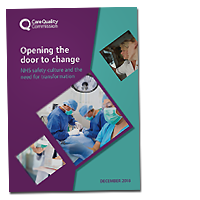This report looks at NHS safety culture and the need for transformation.

The Secretary of State for Health and Social Care asked us to work with NHS Improvement to look at issues in NHS trusts that contribute to Never Events taking place.
Never Events are incidents with the potential to cause serious patient harm or death that are wholly preventable if national guidance or safety recommendations are followed.
We wanted to understand what makes it easier – or harder – for the people and organisations in the NHS to prevent Never Events.
We also wanted to see what could be learned from other industries and countries.
The review sought to answer 4 questions:
- How do trusts regard existing guidance to prevent Never Events?
- How effectively do trusts use safety guidance?
- How do other system partners support the implementation of safety guidance?
- What can we learn from other industries?
What we did
We visited 18 NHS trusts (both acute and mental health) between April and June 2018. We carried out one-to-one interviews, visited different services and reviewed policies and procedures.
We also held forums and workshops with patient representatives, people from the NHS, other healthcare organisations and other industries, as well as safety and human factors experts.
We held focus groups with frontline staff and asked for information from arm’s length bodies about their role in patient safety.
We also spoke to many experts. A key focus was to understand other safety-critical industries’ approach to safety. This included the aviation, nuclear and fire and rescue industries.
What we found
The challenges faced by trusts
Although patient safety alerts are generally seen as an effective way to share safety guidance, the context in which they are landing creates challenges for trusts.
The challenges across the healthcare system as a whole
Arm’s-length bodies, including CQC, royal colleges and professional regulators, have a substantial role to play within patient safety, but the current system is confused and complex, with no clear understanding of how it is organised and who is responsible for what. This makes it difficult for them to prioritise what needs to be done and when.
The challenges in educating and training staff
Various bodies are responsible for different aspects of clinical and wider professional education in England. This includes universities, royal colleges, deaneries, professional regulators, Health Education England and employers like NHS trusts.
It is not easy to establish who is responsible for which elements of education or who has the authority to deem any element of training mandatory, for example around patient safety, and place it consistently within training programmes.
With so many different bodies having a role in education, the importance of patient safety training is slipping through the cracks both at undergraduate level and throughout careers.
Our conclusions
Never Events continue to happen despite the hard work and efforts of frontline staff.
Staff are struggling to cope with large volumes of safety guidance, they have little time and space to implement guidance effectively, and the systems and processes around them are not always supportive.
Where staff are trying to implement guidance, they are often doing this on top of a demanding and busy role that makes it difficult to give the work the time it requires.
In terms of the wider system, we have found that the different parts at national, regional and local level do not always work together in the most supportive way. There is a lot of confusion about the roles of different bodies and where trusts can go to get the most appropriate support.
Also, we found that education and training for patient safety could be significantly improved. Staff are either not getting the training they need at undergraduate level or they are not given the time to do appropriate levels of training on patient safety once they have entered their clinical careers.
Everyone who has a role in health care or who receives health care in England should recognise the importance of making patient safety a top priority and the extent of the cultural change needed to make this a reality.
Download
Opening the door to change – Summary
Join the conversation
Follow #SafetyCulture on Twitter
Related information
Press release: CQC calls for a change in safety culture across the NHS to reduce avoidable harm